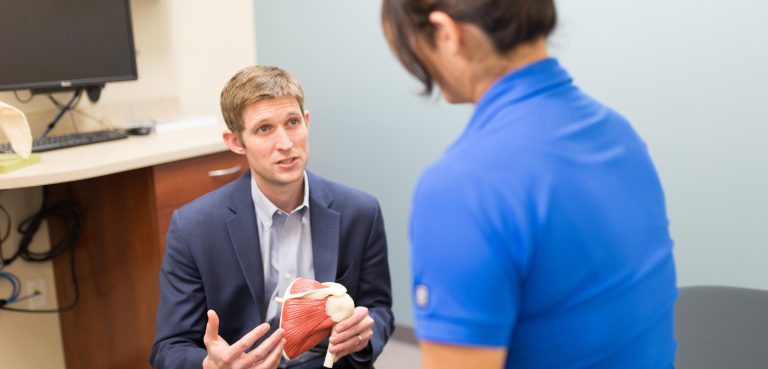Do you have pain in your shoulder when you try to lift a heavy object? How about when you throw a ball or cast a fishing line? Are you having difficulty driving a car because your shoulder pain is too severe?
About six years ago, two individuals came to St. Elizabeth Healthcare complaining about the pain in their shoulder and how it impacted daily living. What followed was shoulder replacement surgery using a first-in-the-world approach — it completely sparred the rotator cuff. Dr. Michael Greiwe, an orthopedic surgeon at OrthoCincy, practicing at St. Elizabeth Healthcare, developed this groundbreaking technique in 2017. For the past half a decade, this surgical approach has brought relief and a better quality of life to those needing shoulder replacement by offering patients a less-invasive procedure.
“Here we are, years later, and the approach continues to appear to be a game changer,” said Dr. Greiwe. “With this technique, surgeons replace the bad shoulder joint without cutting the patient’s rotator cuff,” said Greiwe. “It reduces pain significantly and speeds up healing — exactly what patients seek.”
Traditional Replacement vs. Rotator Cuff-Sparing Shoulder Replacement
Understanding the differences between traditional and rotator cuff-sparing shoulder replacement techniques is important for making an informed decision about your surgical options.
Traditional Shoulder Replacement Surgery
During traditional shoulder replacement surgery, doctors make an incision in the front of the shoulder and cut the front rotator cuff to access and replace the shoulder’s ball and socket joint. They then repair the rotator cuff so the shoulder remains stable.
Rotator Cuff Sparing Surgery
This less invasive surgical technique involves an incision in the back of the shoulder. This entry gives the surgeon a better view and easier access to the affected shoulder joint without compromising the rotator cuff.
When arthritis causes shoulder pain, it can also wear out the socket in the back of the shoulder. “This approach gives a clear view of the shoulder and allows the surgeon to repair other damage that shoulder arthritis can cause,” Dr. Greiwe explains. “Arthritis can stretch out the soft tissue in the back of the shoulder. This surgery allows a repair of the soft tissue to correct more than just the diseased joint.”
Recovery After Rotator Cuff-Sparing Shoulder Replacement
“After undergoing a rotator cuff-sparing shoulder replacement, patients can generally expect a smoother and faster recovery than traditional methods,” says Dr. Greiwe.
Since patients need no additional time to heal the rotator cuff, they can begin rehabilitation sooner. Patients may only need to wear a sling for a short period, typically around several days, instead of the longer timeframe associated with conventional shoulder surgeries.
Physical therapy can usually begin within the first few weeks, focusing on restoring range of motion and building muscle strength. Overall, the rotator cuff sparing approach helps to get patients back to their regular activities, whether it’s work, exercise or family obligations, much more quickly.
Rotator Cuff-Sparing Shoulder Replacement: A Track Record of Success
“We’ve seen exceptional results, says Dr. Greiwe. Patients spend less time on medication, experience less pain and return to their lives more quickly.” The procedure also eliminates potential complications because the rotator cuff stays intact.
Greiwe says patients who have the sparing approach report better outcomes than patients who have traditional replacement surgery, including:
- Faster return to work and social activities.
- Minimal use of pain medication post-surgery.
- Shorter physical therapy and rehabilitation timelines.
- Significant pain reduction.
One of the first patients receiving rotator cuff-sparing shoulder replacement reported feeling no pain after his procedure. He even went fishing the third day after leaving the hospital. He wore a sling for the first two weeks and completed physical therapy in just over a month. Three months after his surgery, he considered himself fully recovered.
After most traditional shoulder replacements, patients can take about six to nine months to fully recover.
Looking ahead, Dr. Greiwe says he is excited the rotator cuff-sparing shoulder replacement method will minimize people’s pain and improve their quality of life. “I’m optimistic this technique will continue to evolve and benefit even more people.”
To discover more about your shoulder replacement options, please visit Shoulder Surgery | KY, OH & IN | St. Elizabeth Healthcare (stelizabeth.com).

